child restraint CHRYSLER VOYAGER 2023 Owners Manual
[x] Cancel search | Manufacturer: CHRYSLER, Model Year: 2023, Model line: VOYAGER, Model: CHRYSLER VOYAGER 2023Pages: 256, PDF Size: 13.97 MB
Page 4 of 256

2
INTRODUCTION
SYMBOLS KEY ....................................................................... 7
VEHICLE MODIFICATIONS/ALTERATIONS ......................... 7
SYMBOL GLOSSARY ............................................................. 7
GETTING TO KNOW YOUR VEHICLE
KEYS ....................................................................................10
Key Fob ........................................................................ 10
SENTRY KEY ........................................................................12
IGNITION SWITCH ...............................................................12 Keyless Enter ‘n Go™ Ignition .................................... 12
REMOTE START — IF EQUIPPED ......................................14 How To Use Remote Start .......................................... 14
To Exit Remote Start Mode ........................................ 14
Remote Start Front Defrost Activation —
If Equipped .................................................................. 15
Remote Start Comfort Systems — If Equipped.......... 15
Remote Start Windshield Wiper De-Icer Activation —
If Equipped .................................................................. 15
Remote Start Cancel Message .................................. 15
VEHICLE SECURITY SYSTEM — IF EQUIPPED ..................16 To Arm The System .................................................... 16
To Disarm The System ................................................ 16
Rearming Of The System ............................................ 16
Security System Manual Override.............................. 16
DOORS..................................................................................16 Manual Door Locks ..................................................... 16
Power Door Locks — If Equipped ............................... 17
Keyless Enter ‘n Go™ — Passive Entry ..................... 18
Automatic Unlock Doors On Exit — If Equipped......... 19
Manual Sliding Side Door ........................................... 20
Power Sliding Side Door — If Equipped ..................... 20
Child Protection Door Lock System — Rear Doors .... 21 STEERING WHEEL .............................................................. 22
Tilt/Telescoping Steering Column ..............................22
Heated Steering Wheel — If Equipped........................ 22
SEATS ................................................................................... 23 Manual Adjustment
(Front Seats) — If Equipped......................................... 23
Manual Adjustment (Rear Seats) ............................... 24
Power Adjustment (Front Seats) — If Equipped ......... 33
Heated Seats .............................................................. 34
Head Restraints .......................................................... 35
UCONNECT VOICE RECOGNITION —
IF EQUIPPED ........................................................................ 37 Introducing Voice Recognition .................................... 37
Basic Voice Commands............................................... 37
Get Started ................................................................... 37
Additional Information................................................. 37
MIRRORS ............................................................................. 38 Inside Rearview Mirror ................................................ 38
Illuminated Vanity Mirrors — If Equipped .................. 38
Outside Mirrors ........................................................... 38
Conversation Mirror ..................................................... 38
Power Mirrors — If Equipped ....................................... 39
Outside Mirrors Folding Feature ................................. 39
Heated Mirrors — If Equipped ..................................... 39
EXTERIOR LIGHTS............................................................... 39 Multifunction Lever......................................................39
Headlight Switch .......................................................... 39
Daytime Running Lights (DRLs) — If Equipped .......... 40
High/Low Beam Switch ............................................... 40
Flash-To-Pass ...............................................................40
Automatic Headlights — If Equipped .......................... 40
Headlight Time Delay — If Equipped........................... 41 Lights-On Reminder..................................................... 41
Turn Signals ................................................................. 41
Lane Change Assist — If Equipped ............................. 41
Battery Protection ....................................................... 41
INTERIOR LIGHTS .............................................................. 41 Interior Courtesy Lights .............................................. 41
WINDSHIELD WIPER AND WASHERS ............................ 42 Windshield Wiper Operation ....................................... 42
Rain Sensing Wipers — If Equipped ........................... 43
Rear Wiper And Washer .............................................. 44
CLIMATE CONTROLS ......................................................... 44 Manual Climate Control Descriptions And
Functions ..................................................................... 44
Climate Voice Commands........................................... 48
Operating Tips ............................................................ 48
INTERIOR STORAGE AND EQUIPMENT............................ 49 Storage ......................................................................... 49
USB/AUX Control ........................................................ 52
Power Outlets ............................................................. 52
WINDOWS ........................................................................... 54 Power Windows ........................................................... 54
Automatic Window Features....................................... 55
Reset Auto Up .............................................................. 55
Wind Buffeting ............................................................. 55
HOOD ................................................................................... 56 Opening ........................................................................ 56
Closing.......................................................................... 56
LIFTGATE ............................................................................. 56 To Unlock/Open The Liftgate...................................... 56
To Lock/Close The Liftgate ......................................... 57
Power Liftgate — If Equipped ...................................... 57
Cargo Area Features .................................................. 58
23_RUV_OM_EN_US_t.book Page 2
Page 6 of 256
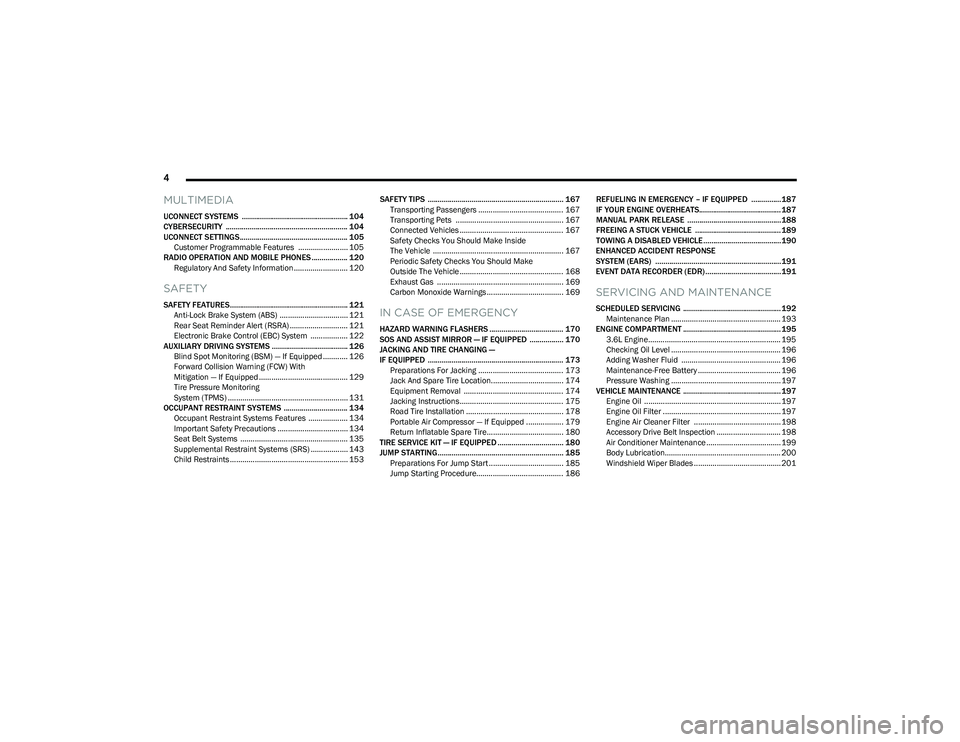
4
MULTIMEDIA
UCONNECT SYSTEMS ..................................................... 104
CYBERSECURITY ............................................................. 104
UCONNECT SETTINGS...................................................... 105
Customer Programmable Features ........................ 105
RADIO OPERATION AND MOBILE PHONES .................. 120 Regulatory And Safety Information .......................... 120
SAFETY
SAFETY FEATURES........................................................... 121Anti-Lock Brake System (ABS) ................................. 121Rear Seat Reminder Alert (RSRA) ............................ 121
Electronic Brake Control (EBC) System .................. 122
AUXILIARY DRIVING SYSTEMS ...................................... 126 Blind Spot Monitoring (BSM) — If Equipped ............ 126Forward Collision Warning (FCW) With
Mitigation — If Equipped ........................................... 129
Tire Pressure Monitoring
System (TPMS) .......................................................... 131
OCCUPANT RESTRAINT SYSTEMS ................................ 134 Occupant Restraint Systems Features ................... 134Important Safety Precautions .................................. 134Seat Belt Systems .................................................... 135
Supplemental Restraint Systems (SRS) .................. 143Child Restraints ......................................................... 153 SAFETY TIPS .................................................................... 167
Transporting Passengers ......................................... 167
Transporting Pets .................................................... 167
Connected Vehicles .................................................. 167Safety Checks You Should Make Inside
The Vehicle ............................................................... 167Periodic Safety Checks You Should Make
Outside The Vehicle .................................................. 168Exhaust Gas ............................................................. 169
Carbon Monoxide Warnings ..................................... 169IN CASE OF EMERGENCY
HAZARD WARNING FLASHERS ..................................... 170
SOS AND ASSIST MIRROR — IF EQUIPPED ................. 170
JACKING AND TIRE CHANGING —
IF EQUIPPED .................................................................... 173 Preparations For Jacking ......................................... 173
Jack And Spare Tire Location................................... 174Equipment Removal ................................................ 174
Jacking Instructions.................................................. 175Road Tire Installation ............................................... 178
Portable Air Compressor — If Equipped .................. 179
Return Inflatable Spare Tire..................................... 180
TIRE SERVICE KIT — IF EQUIPPED ................................. 180
JUMP STARTING............................................................... 185 Preparations For Jump Start .................................... 185Jump Starting Procedure.......................................... 186 REFUELING IN EMERGENCY – IF EQUIPPED ...............187
IF YOUR ENGINE OVERHEATS......................................... 187
MANUAL PARK RELEASE ...............................................188
FREEING A STUCK VEHICLE ........................................... 189
TOWING A DISABLED VEHICLE.......................................190
ENHANCED ACCIDENT RESPONSE
SYSTEM (EARS) ...............................................................191
EVENT DATA RECORDER (EDR)......................................191
SERVICING AND MAINTENANCE
SCHEDULED SERVICING ................................................. 192 Maintenance Plan ..................................................... 193
ENGINE COMPARTMENT ................................................. 195 3.6L Engine................................................................ 195
Checking Oil Level ..................................................... 196Adding Washer Fluid ................................................ 196
Maintenance-Free Battery ........................................ 196Pressure Washing ..................................................... 197
VEHICLE MAINTENANCE ................................................. 197 Engine Oil .................................................................. 197
Engine Oil Filter ......................................................... 197
Engine Air Cleaner Filter .......................................... 198
Accessory Drive Belt Inspection ............................... 198Air Conditioner Maintenance .................................... 199
Body Lubrication........................................................ 200
Windshield Wiper Blades .......................................... 201
23_RUV_OM_EN_US_t.book Page 4
Page 28 of 256
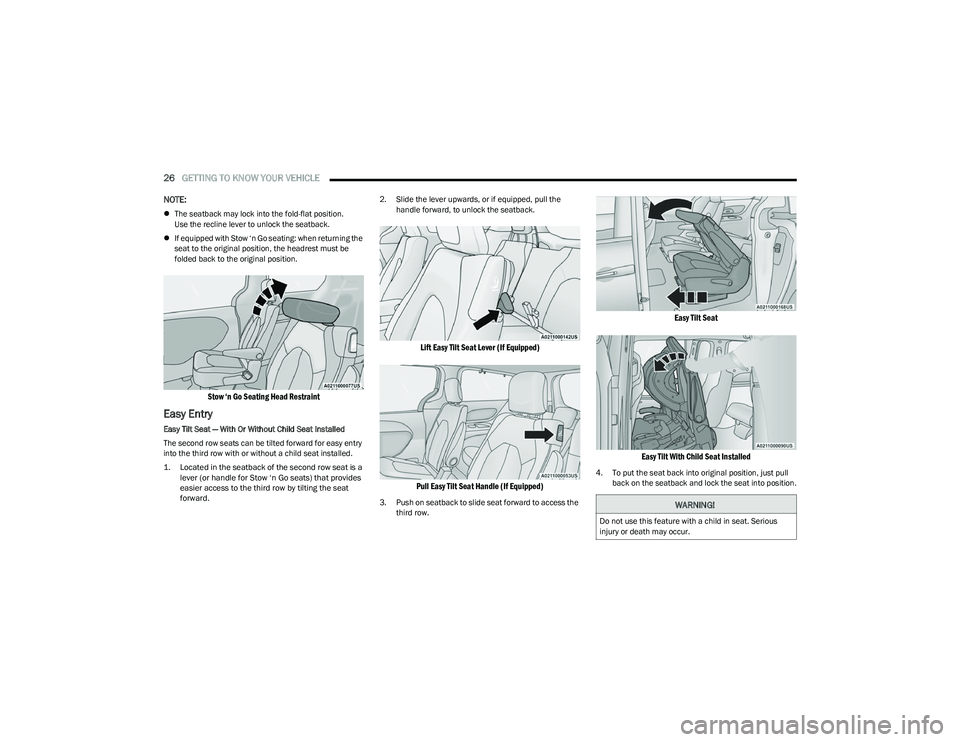
26GETTING TO KNOW YOUR VEHICLE
NOTE:
The seatback may lock into the fold-flat position.
Use the recline lever to unlock the seatback.
If equipped with Stow ‘n Go seating: when returning the
seat to the original position, the headrest must be
folded back to the original position.
Stow ‘n Go Seating Head Restraint
Easy Entry
Easy Tilt Seat — With Or Without Child Seat Installed
The second row seats can be tilted forward for easy entry
into the third row with or without a child seat installed.
1. Located in the seatback of the second row seat is a
lever (or handle for Stow ‘n Go seats) that provides
easier access to the third row by tilting the seat
forward.
2. Slide the lever upwards, or if equipped, pull the
handle forward, to unlock the seatback.
Lift Easy Tilt Seat Lever (If Equipped)
Pull Easy Tilt Seat Handle (If Equipped)
3. Push on seatback to slide seat forward to access the third row.
Easy Tilt Seat
Easy Tilt With Child Seat Installed
4. To put the seat back into original position, just pull back on the seatback and lock the seat into position.
WARNING!
Do not use this feature with a child in seat. Serious
injury or death may occur.
23_RUV_OM_EN_US_t.book Page 26
Page 136 of 256
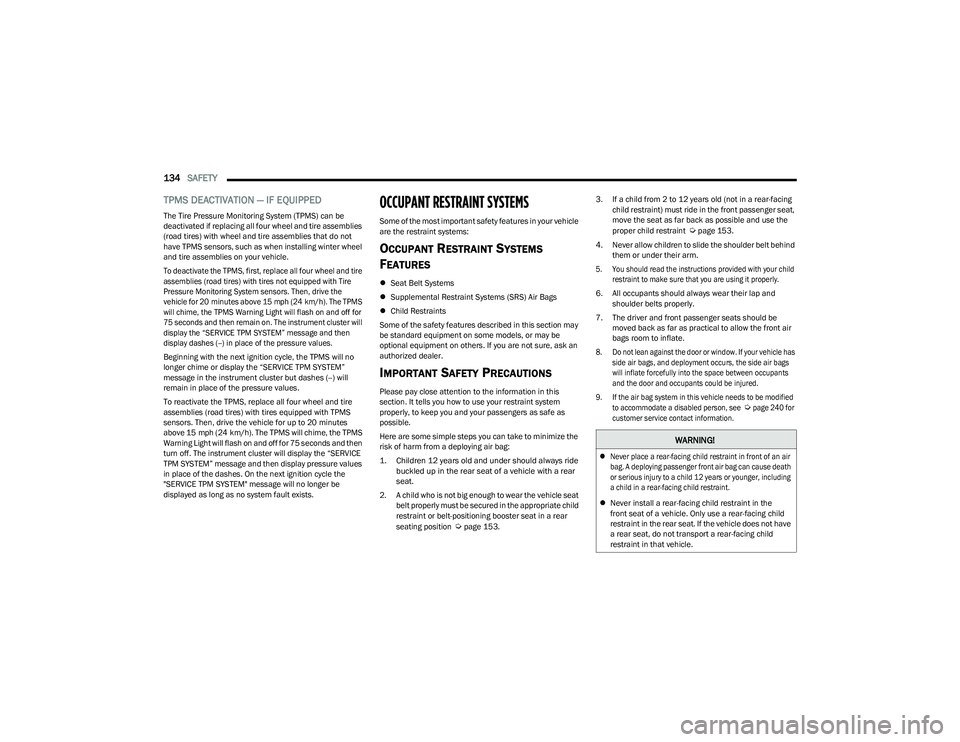
134SAFETY
TPMS DEACTIVATION — IF EQUIPPED
The Tire Pressure Monitoring System (TPMS) can be
deactivated if replacing all four wheel and tire assemblies
(road tires) with wheel and tire assemblies that do not
have TPMS sensors, such as when installing winter wheel
and tire assemblies on your vehicle.
To deactivate the TPMS, first, replace all four wheel and tire
assemblies (road tires) with tires not equipped with Tire
Pressure Monitoring System sensors. Then, drive the
vehicle for 20 minutes above 15 mph (24 km/h). The TPMS
will chime, the TPMS Warning Light will flash on and off for
75 seconds and then remain on. The instrument cluster will
display the “SERVICE TPM SYSTEM” message and then
display dashes (--) in place of the pressure values.
Beginning with the next ignition cycle, the TPMS will no
longer chime or display the “SERVICE TPM SYSTEM”
message in the instrument cluster but dashes (--) will
remain in place of the pressure values.
To reactivate the TPMS, replace all four wheel and tire
assemblies (road tires) with tires equipped with TPMS
sensors. Then, drive the vehicle for up to 20 minutes
above 15 mph (24 km/h). The TPMS will chime, the TPMS
Warning Light will flash on and off for 75 seconds and then
turn off. The instrument cluster will display the “SERVICE
TPM SYSTEM” message and then display pressure values
in place of the dashes. On the next ignition cycle the
"SERVICE TPM SYSTEM" message will no longer be
displayed as long as no system fault exists.OCCUPANT RESTRAINT SYSTEMS
Some of the most important safety features in your vehicle
are the restraint systems:
OCCUPANT RESTRAINT SYSTEMS
F
EATURES
Seat Belt Systems
Supplemental Restraint Systems (SRS) Air Bags
Child Restraints
Some of the safety features described in this section may
be standard equipment on some models, or may be
optional equipment on others. If you are not sure, ask an
authorized dealer.
IMPORTANT SAFETY PRECAUTIONS
Please pay close attention to the information in this
section. It tells you how to use your restraint system
properly, to keep you and your passengers as safe as
possible.
Here are some simple steps you can take to minimize the
risk of harm from a deploying air bag:
1. Children 12 years old and under should always ride buckled up in the rear seat of a vehicle with a rear
seat.
2. A child who is not big enough to wear the vehicle seat belt properly must be secured in the appropriate child
restraint or belt-positioning booster seat in a rear
seating position
Úpage 153. 3. If a child from 2 to 12 years old (not in a rear-facing
child restraint) must ride in the front passenger seat,
move the seat as far back as possible and use the
proper child restraint
Úpage 153.
4. Never allow children to slide the shoulder belt behind them or under their arm.
5. You should read the instructions provided with your child restraint to make sure that you are using it properly.
6. All occupants should always wear their lap and shoulder belts properly.
7. The driver and front passenger seats should be moved back as far as practical to allow the front air
bags room to inflate.
8. Do not lean against the door or window. If your vehicle has side air bags, and deployment occurs, the side air bags
will inflate forcefully into the space between occupants
and the door and occupants could be injured.
9. If the air bag system in this vehicle needs to be modified to accommodate a disabled person, see
Ú
page 240 for
customer service contact information.
WARNING!
Never place a rear-facing child restraint in front of an air
bag. A deploying passenger front air bag can cause death
or serious injury to a child 12 years or younger, including
a child in a rear-facing child restraint.
Never install a rear-facing child restraint in the
front seat of a vehicle. Only use a rear-facing child
restraint in the rear seat. If the vehicle does not have
a rear seat, do not transport a rear-facing child
restraint in that vehicle.
23_RUV_OM_EN_US_t.book Page 134
Page 142 of 256
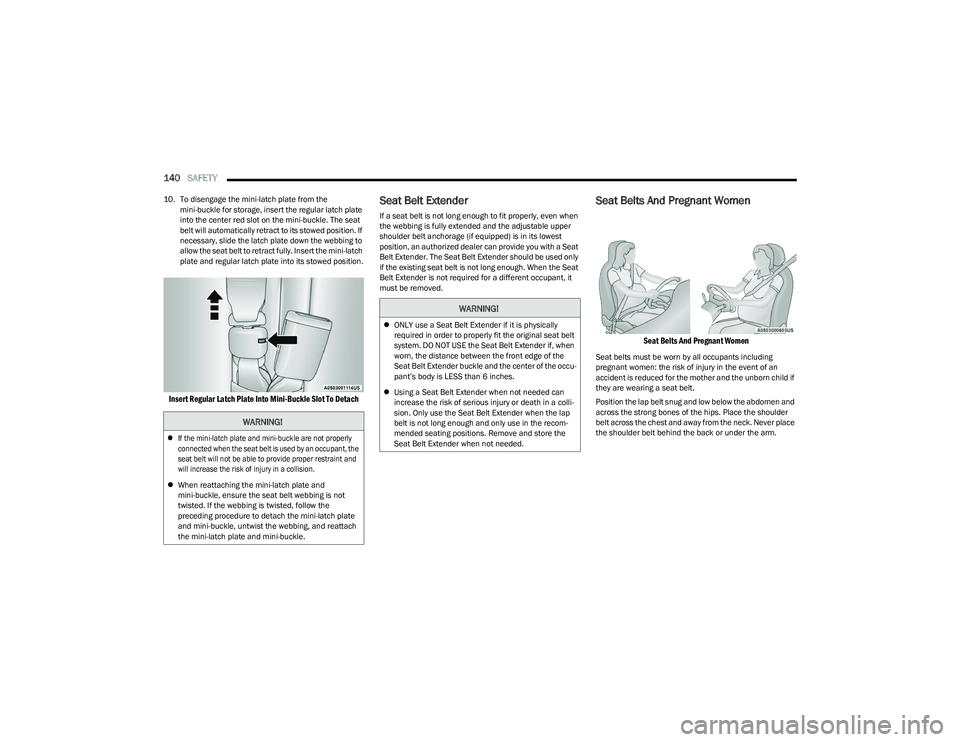
140SAFETY
10. To disengage the mini-latch plate from the
mini-buckle for storage, insert the regular latch plate
into the center red slot on the mini-buckle. The seat
belt will automatically retract to its stowed position. If
necessary, slide the latch plate down the webbing to
allow the seat belt to retract fully. Insert the mini-latch
plate and regular latch plate into its stowed position.
Insert Regular Latch Plate Into Mini-Buckle Slot To Detach
Seat Belt Extender
If a seat belt is not long enough to fit properly, even when
the webbing is fully extended and the adjustable upper
shoulder belt anchorage (if equipped) is in its lowest
position, an authorized dealer can provide you with a Seat
Belt Extender. The Seat Belt Extender should be used only
if the existing seat belt is not long enough. When the Seat
Belt Extender is not required for a different occupant, it
must be removed.
Seat Belts And Pregnant Women
Seat Belts And Pregnant Women
Seat belts must be worn by all occupants including
pregnant women: the risk of injury in the event of an
accident is reduced for the mother and the unborn child if
they are wearing a seat belt.
Position the lap belt snug and low below the abdomen and
across the strong bones of the hips. Place the shoulder
belt across the chest and away from the neck. Never place
the shoulder belt behind the back or under the arm.
WARNING!
If the mini-latch plate and mini-buckle are not properly
connected when the seat belt is used by an occupant, the
seat belt will not be able to provide proper restraint and
will increase the risk of injury in a collision.
When reattaching the mini-latch plate and
mini-buckle, ensure the seat belt webbing is not
twisted. If the webbing is twisted, follow the
preceding procedure to detach the mini-latch plate
and mini-buckle, untwist the webbing, and reattach
the mini-latch plate and mini-buckle.
WARNING!
ONLY use a Seat Belt Extender if it is physically
required in order to properly fit the original seat belt
system. DO NOT USE the Seat Belt Extender if, when
worn, the distance between the front edge of the
Seat Belt Extender buckle and the center of the occu -
pant’s body is LESS than 6 inches.
Using a Seat Belt Extender when not needed can
increase the risk of serious injury or death in a colli-
sion. Only use the Seat Belt Extender when the lap
belt is not long enough and only use in the recom -
mended seating positions. Remove and store the
Seat Belt Extender when not needed.
23_RUV_OM_EN_US_t.book Page 140
Page 143 of 256

SAFETY141
Seat Belt Pretensioner
The front outboard seat belt system is equipped with
pretensioning devices that are designed to remove slack
from the seat belt in the event of a collision. These devices
may improve the performance of the seat belt by removing
slack from the seat belt early in a collision. Pretensioners
work for all size occupants, including those in child
restraints.
NOTE:These devices are not a substitute for proper seat belt
placement by the occupant. The seat belt still must be
worn snugly and positioned properly.
The pretensioners are triggered by the Occupant Restraint
Controller (ORC). Like the air bags, the pretensioners are
single use items. A deployed pretensioner or a deployed
air bag must be replaced immediately.
Energy Management Feature
The front outboard seat belt system is equipped with an
Energy Management feature that may help further reduce
the risk of injury in the event of a collision. The seat belt
system has a retractor assembly that is designed to
release webbing in a controlled manner.
Switchable Automatic Locking
Retractors (ALR)
The seat belts in the passenger seating positions are
equipped with a Switchable Automatic Locking Retractor
(ALR) which is used to secure a child restraint system
Úpage 161.
The figure below illustrates the locking feature for each
seating position.
7 Passenger Bench Seat Automatic Locking Retractor (ALR) Locations 7 Passenger Quad Seat Automatic Locking Retractor (ALR)
Locations (Includes Stow ‘n Go)
8 Passenger Automatic Locking Retractor (ALR) Locations
ALR — Switchable Automatic Locking Retractor
ALR — Switchable Automatic Locking Retractor
ALR — Switchable Automatic Locking Retractor
6
23_RUV_OM_EN_US_t.book Page 141
Page 144 of 256

142SAFETY
If the passenger seating position is equipped with an ALR
and is being used for normal usage, only pull the seat belt
webbing out far enough to comfortably wrap around the
occupant’s mid-section so as to not activate the ALR. If the
ALR is activated, you will hear a clicking sound as the seat
belt retracts. Allow the webbing to retract completely in
this case and then carefully pull out only the amount of
webbing necessary to comfortably wrap around the
occupant’s mid-section. Slide the latch plate into the
buckle until you hear a "click."
In Automatic Locking Mode, the shoulder belt is
automatically pre-locked. The seat belt will still retract to
remove any slack in the shoulder belt. Use the Automatic
Locking Mode anytime a child restraint is installed in a
seating position that has a seat belt with this feature.
Children 12 years old and under should always be properly
restrained in the rear seat of a vehicle with a rear seat. How To Engage The Automatic Locking Mode
1. Buckle the combination lap and shoulder belt.
2. Grab the shoulder portion and pull downward until
the entire seat belt is extracted.
3. Allow the seat belt to retract. As the seat belt retracts, you will hear a clicking sound. This indicates the seat
belt is now in the Automatic Locking Mode.
How To Disengage The Automatic Locking Mode
Unbuckle the combination lap/shoulder belt and allow it
to retract completely to disengage the Automatic Locking
Mode and activate the vehicle sensitive (emergency)
locking mode.Seat Belt Park Stitch — If Equipped
The rear outboard seat belts may be equipped with a park stitch
to raise the latch plate for easier access to occupants. If the
park stitch interferes with the tight installation of a child
restraint, slide the latch plate over the stitching to shorten the
lap portion of the belt and install the car seat normally. When
the car seat is removed from the vehicle, slide the latch plate
above the park stitch to enable occupants to latch the seat belt
securely.
Seat Belt Park Stitch Location
WARNING!
Never place a rear-facing child restraint in front of an
air bag. A deploying passenger front air bag can
cause death or serious injury to a child 12 years or
younger, including a child in a rear-facing child
restraint.
Never install a rear-facing child restraint in the
front seat of a vehicle. Only use a rear-facing child
restraint in the rear seat. If the vehicle does not have
a rear seat, do not transport a rear-facing child
restraint in that vehicle.
WARNING!
The seat belt assembly must be replaced if the
switchable Automatic Locking Retractor (ALR)
feature or any other seat belt function is not working
properly when checked according to the procedures
in the Service Manual.
Failure to replace the seat belt assembly could
increase the risk of injury in collisions.
Do not use the Automatic Locking Mode to restrain occu-
pants who are wearing the seat belt or children who are
using booster seats. The locked mode is only used to
install rear-facing or forward-facing child restraints that
have a harness for restraining the child.
23_RUV_OM_EN_US_t.book Page 142
Page 146 of 256
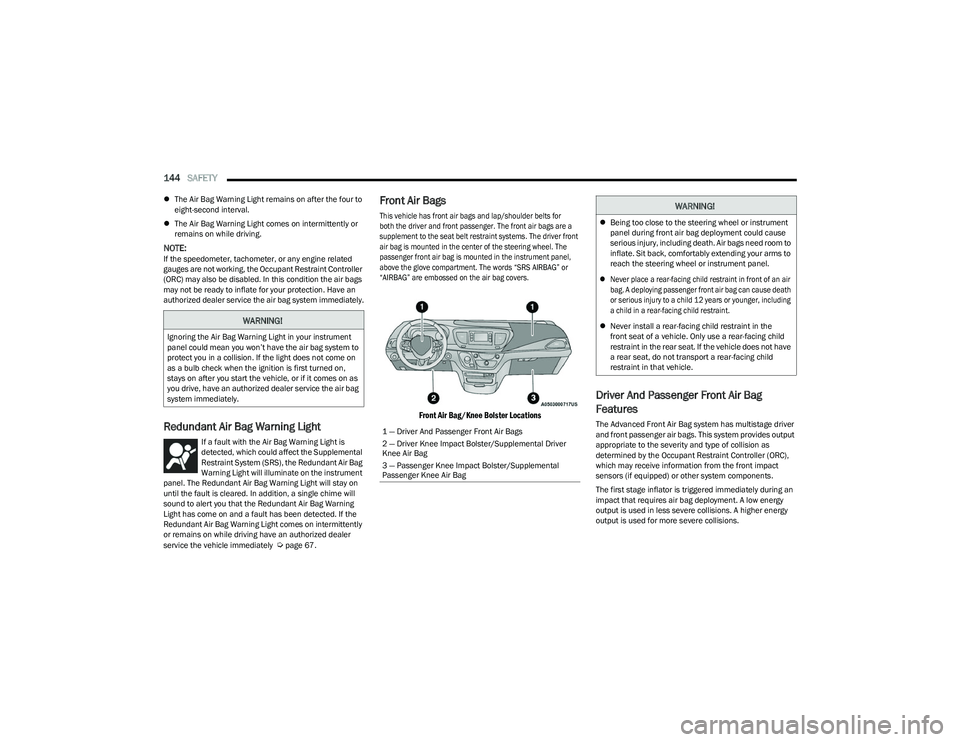
144SAFETY
The Air Bag Warning Light remains on after the four to
eight-second interval.
The Air Bag Warning Light comes on intermittently or
remains on while driving.
NOTE:If the speedometer, tachometer, or any engine related
gauges are not working, the Occupant Restraint Controller
(ORC) may also be disabled. In this condition the air bags
may not be ready to inflate for your protection. Have an
authorized dealer service the air bag system immediately.
Redundant Air Bag Warning Light
If a fault with the Air Bag Warning Light is
detected, which could affect the Supplemental
Restraint System (SRS), the Redundant Air Bag
Warning Light will illuminate on the instrument
panel. The Redundant Air Bag Warning Light will stay on
until the fault is cleared. In addition, a single chime will
sound to alert you that the Redundant Air Bag Warning
Light has come on and a fault has been detected. If the
Redundant Air Bag Warning Light comes on intermittently
or remains on while driving have an authorized dealer
service the vehicle immediately
Úpage 67.
Front Air Bags
This vehicle has front air bags and lap/shoulder belts for
both the driver and front passenger. The front air bags are a
supplement to the seat belt restraint systems. The driver front
air bag is mounted in the center of the steering wheel. The
passenger front air bag is mounted in the instrument panel,
above the glove compartment. The words “SRS AIRBAG” or
“AIRBAG” are embossed on the air bag covers.
Front Air Bag/Knee Bolster Locations
Driver And Passenger Front Air Bag
Features
The Advanced Front Air Bag system has multistage driver
and front passenger air bags. This system provides output
appropriate to the severity and type of collision as
determined by the Occupant Restraint Controller (ORC),
which may receive information from the front impact
sensors (if equipped) or other system components.
The first stage inflator is triggered immediately during an
impact that requires air bag deployment. A low energy
output is used in less severe collisions. A higher energy
output is used for more severe collisions.
WARNING!
Ignoring the Air Bag Warning Light in your instrument
panel could mean you won’t have the air bag system to
protect you in a collision. If the light does not come on
as a bulb check when the ignition is first turned on,
stays on after you start the vehicle, or if it comes on as
you drive, have an authorized dealer service the air bag
system immediately.
1 — Driver And Passenger Front Air Bags
2 — Driver Knee Impact Bolster/Supplemental Driver
Knee Air Bag
3 — Passenger Knee Impact Bolster/Supplemental
Passenger Knee Air Bag
WARNING!
Being too close to the steering wheel or instrument
panel during front air bag deployment could cause
serious injury, including death. Air bags need room to
inflate. Sit back, comfortably extending your arms to
reach the steering wheel or instrument panel.
Never place a rear-facing child restraint in front of an air
bag. A deploying passenger front air bag can cause death
or serious injury to a child 12 years or younger, including
a child in a rear-facing child restraint.
Never install a rear-facing child restraint in the
front seat of a vehicle. Only use a rear-facing child
restraint in the rear seat. If the vehicle does not have
a rear seat, do not transport a rear-facing child
restraint in that vehicle.
23_RUV_OM_EN_US_t.book Page 144
Page 148 of 256
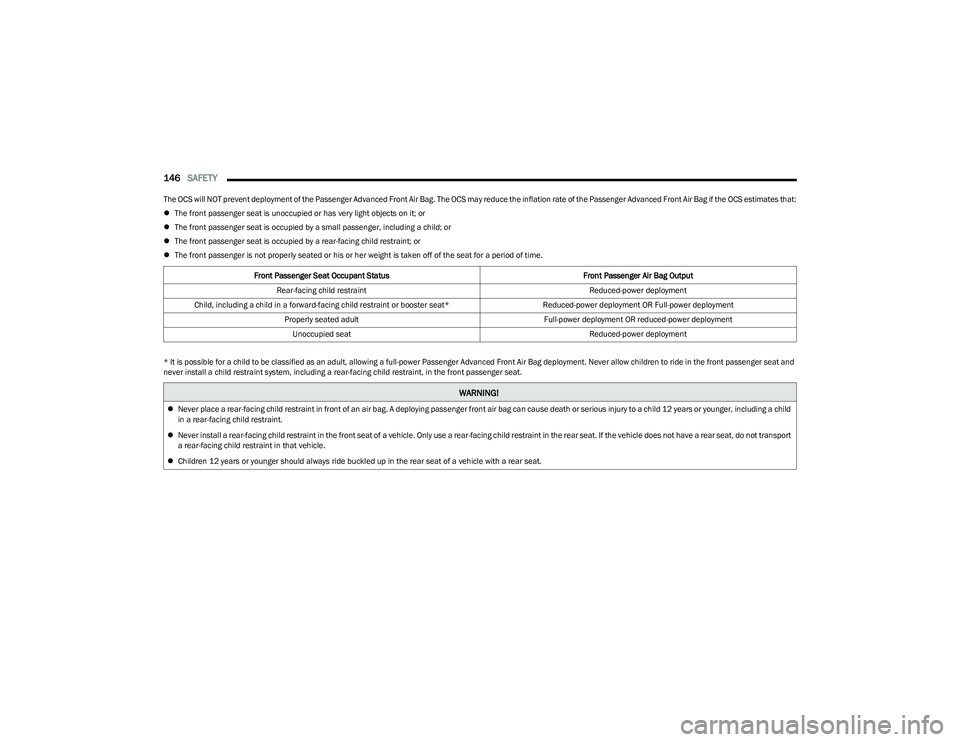
146SAFETY
The OCS will NOT prevent deployment of the Passenger Advanced Front Air Bag. The OCS may reduce the inflation rate of the Passenger Advanced Front Air Bag if the OCS estimates that:
The front passenger seat is unoccupied or has very light objects on it; or
The front passenger seat is occupied by a small passenger, including a child; or
The front passenger seat is occupied by a rear-facing child restraint; or
The front passenger is not properly seated or his or her weight is taken off of the seat for a period of time.
* It is possible for a child to be classified as an adult, allowing a full-power Passenger Advanced Front Air Bag deployment. Never allow children to ride in the front passenger seat and
never install a child restraint system, including a rear-facing child restraint, in the front passenger seat. Front Passenger Seat Occupant Status
Front Passenger Air Bag Output
Rear-facing child restraint Reduced-power deployment
Child, including a child in a forward-facing child restraint or booster seat* Reduced-power deployment OR Full-power deployment
Properly seated adult Full-power deployment OR reduced-power deployment
Unoccupied seat Reduced-power deployment
WARNING!
Never place a rear-facing child restraint in front of an air bag. A deploying passenger front air bag can cause death or serious injury to a child 12 years or younger, including a child
in a rear-facing child restraint.
Never install a rear-facing child restraint in the front seat of a vehicle. Only use a rear-facing child restraint in the rear seat. If the vehicle does not have a rear seat, do not transport
a rear-facing child restraint in that vehicle.
Children 12 years or younger should always ride buckled up in the rear seat of a vehicle with a rear seat.
23_RUV_OM_EN_US_t.book Page 146
Page 150 of 256
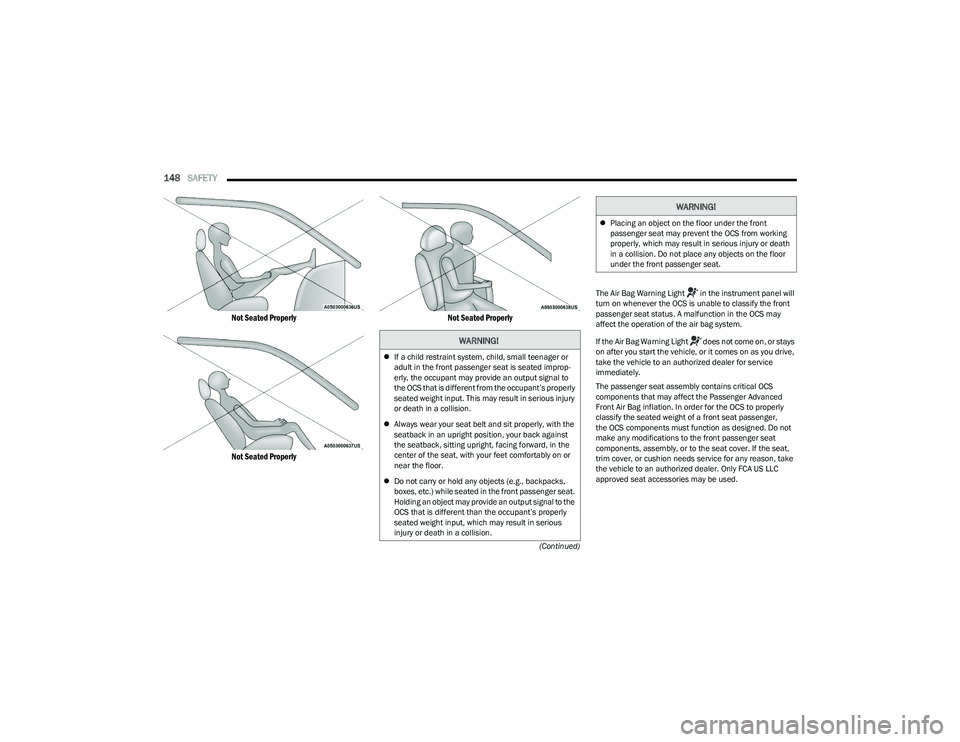
148SAFETY
(Continued)
Not Seated Properly
Not Seated Properly Not Seated Properly
The Air Bag Warning Light in the instrument panel will
turn on whenever the OCS is unable to classify the front
passenger seat status. A malfunction in the OCS may
affect the operation of the air bag system.
If the Air Bag Warning Light does not come on, or stays
on after you start the vehicle, or it comes on as you drive,
take the vehicle to an authorized dealer for service
immediately.
The passenger seat assembly contains critical OCS
components that may affect the Passenger Advanced
Front Air Bag inflation. In order for the OCS to properly
classify the seated weight of a front seat passenger,
the OCS components must function as designed. Do not
make any modifications to the front passenger seat
components, assembly, or to the seat cover. If the seat,
trim cover, or cushion needs service for any reason, take
the vehicle to an authorized dealer. Only FCA US LLC
approved seat accessories may be used.
WARNING!
If a child restraint system, child, small teenager or
adult in the front passenger seat is seated improp -
erly, the occupant may provide an output signal to
the OCS that is different from the occupant’s properly
seated weight input. This may result in serious injury
or death in a collision.
Always wear your seat belt and sit properly, with the
seatback in an upright position, your back against
the seatback, sitting upright, facing forward, in the
center of the seat, with your feet comfortably on or
near the floor.
Do not carry or hold any objects (e.g., backpacks,
boxes, etc.) while seated in the front passenger seat.
Holding an object may provide an output signal to the
OCS that is different than the occupant’s properly
seated weight input, which may result in serious
injury or death in a collision.
Placing an object on the floor under the front
passenger seat may prevent the OCS from working
properly, which may result in serious injury or death
in a collision. Do not place any objects on the floor
under the front passenger seat.
WARNING!
23_RUV_OM_EN_US_t.book Page 148